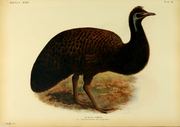| Dromaius Temporal range: Miocene–present Middle Miocene | |
|---|---|
| File:Emoe.jpg | |
| Dromaius novaehollandiae | |
| Scientific classification | |
| Kingdom: | Animalia |
| Phylum: | Chordata |
| Class: | Aves |
| Order: | Struthioniformes (or Casuariiformes) |
| Family: | Casuariidae |
| Subfamily: | Dromaiinae |
| Tribe: | Dromaiini |
| Genus: | Dromaius Vieillot, 1816[1] |
| Type species | |
| Casuarius novaehollandiae Latham, 1790 | |
| Species | |
|
D. novaehollandiae Emu | |
| Synonyms | |
|
Dromiceius (Vieillot, 1816) | |
| This page uses Creative Commons Licensed content from Wikipedia (view authors). Please help by writing it in the style of All Birds Wiki! |
Dromaius is a genus of Ratite present in Australia. There is one extant species, Dromaius novaehollandiae commonly known as the Emu.
In his original 1816 description of the emu, Vieillot used two generic names; first Dromiceius, then Dromaius a few pages later. It has been a point of contention ever since which is correct; the latter is more correctly formed, but the convention in taxonomy is that the first name given stands, unless it is clearly a typographical error.[2] Most modern publications, including those of the Australian government,[3] use Dromaius, with Dromiceius mentioned as an alternative spelling. Others misspelling synonyms are descript for genus (see synonyms in taxobox).[3] However, the Dromiceius spelling was used by Russell in his 1972 naming of the dinosaur Dromiceiomimus.
Species and sub-species
Facial detail of an emu
King Island Emu

Kangaroo Island Emu
Three different emu species were common prior to European settlement in 1788:
- Dromaius novaehollandiae, Emu, remains common in most of the more lightly settled parts of mainland Australia. Overall population varies from decade to decade according to rainfall; as low as 200,000 and as high as a million, but a typical figure is about half a million individuals. Although emus are no longer found in the densely settled southern and south-western agricultural areas, the provision of permanent stock water in arid regions has allowed the mainland species to extend its range. There are three current sub-species or races of the emu across Australia:
- Dromaius novaehollandiae novaehollandiae - South-east Australia - whitish ruff when breeding.
- Dromaius novaehollandiae woodwardi - North Australia - slender, paler.
- Dromaius novaehollandiae rothschildi - South-west Australia - darker, no ruff during breeding.
- Dromaius novaehollandiae diemenensis - Tasmania - The Tasmanian Emu, became extinct around 1850.
- Dromaius baudinianus, Kangaroo Island Emu became extinct around 1827 as a result of hunting and frequent fires. The larger mainland species was introduced to Kangaroo Island in the 1920s.
- Dromaius ater, King Island Emu was about half the size of the mainland species. By 1805 it had been hunted to extinction by sealers and visiting sailors. Some individuals were kept in captivity in Paris, the last one dying in 1822.
- Dromaius ocypus, a prehistoric species of emu (A.H. Miller, 1963), described from Late Pliocene fossils (Mampuwordu Sands Formation, Lake Palankarinna, Australia) accepted as distinct nowadays.
A number of other Emu fossils from Australia described as separate species are now regarded as chronosubspecies at best, given the considerable variation even between living individuals.[4] There are also some unidentifiable remains of emu-like birds from rocks as old as the middle Miocene.[5]
Footnotes
References
- Alexander, W.B. (1927) [http://elibrary.unm.edu/sora/Auk/v044n04/p0592-p0593.pdf SORASearchable
| Projects | ||||
|---|---|---|---|---|
| ||||


